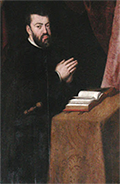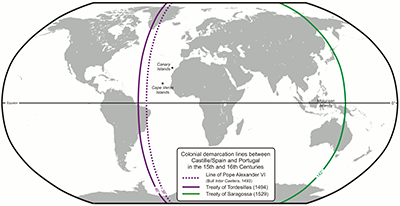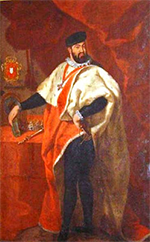King John III of Portugal
John III was King of Portugal for 36 years in the 16th Century, guiding his country further down the road of global preeminence in the Age of Exploration. 
He was born on June 6, 1502, in Lisbon, the capital city. His father was the reigning monarch, King Manuel I, and his mother was Maria of Castile. In 1518, when John was 16, he was to marry Eleanor of Austria. However, Eleanor instead married John's father, Manuel, whose wife, Maria (also John's mother), had died the year before. The arrangement stunned John, who, still grieving at the death of his mother, became quite serious and devout in response. He was thereafter known as John the Pious. When the king died, in 1521, John became king. He was 19 and old enough to rule in his own right. He married Catherine, whose brother was Spain's King Charles I (and later Charles V of the Holy Roman Empire). About the same time, John's sister Isabella married the Spanish king. 
Portugal and Spain had been competing for possessions in the New World ever since they agreed on the first Treaty of Tordesillas in 1494. Yet another agreement, the 1529 Treaty of Zaragosa, gave the Moluccas to Portugal and the Philippines to Spain. The Moluccas were one of the goals of the circumnavigation expedition of Ferdinand Magellan, the Portuguese sailor who sailed under a Spanish flag. John's royal predecessors had been focused on India, and he continued that focus on the East, ordering the conquest of the city of Diu in 1535 and establishing a settlement in Macao. All of these developments were meant to bolster the strong spice trade. The truth was, however, that the far-flung nature of the Portuguese possessions were becoming more and more of a drain on the Crown, especially as traditional competitors like France and Holland and Spain continued to thrive and as new enemies in the form of the Ottoman Empire emerged. One of the things that John did to try to offset this was to let go of some holdings in North Africa that his predecessors had worked hard to get. Also as a form of diplomacy and perhaps protection, John was the first European monarch to make formal contact with Japan. 
In 1533, three decades after the Portuguese explorer Pedro Álvares Cabral first claimed Brazil for king and country, John III set about organizing settlements there. First came the Captaincy Colonies of Brazil, from 1534. In 1549 came a central government, in Bahia. This earned the king the appellation John the Colonizer. Although it took some time for Portugal to set up colonies in Brazil, Portuguese traders almost immediately began to ship goods back from there. Among the well-known products to flow from New World to Old were sugar cane and brazilwood, a special form of wood used to make dye. 
Emphasizing his piety, John in 1536 introduced the Inquisition into Portugal. Although not as severe as its counterpart in Spain, this enterprise did its share of rooting out enemies of Catholicism. At the same time, John III was a strong patron of humanism and supported many authors and scientists. He poured money and effort into upgrading his own country's schools of learnings and also awarded many scholarships to universities in other countries. John and Catherine had nine children, none of whom survived into adulthood. In 1539, when their son John was 2, the king named his namesake his heir. John got married in 1552, to Princess Joanna of Spain. The crown prince died in January 1554, when his wife was heavily pregnant; a short time later, she gave birth to a son, Sebastian. When John III died, on June 11, 1557, the young Sebastian inherited the throne.
|
|
Social Studies for Kids
copyright 2002–2026
David White




